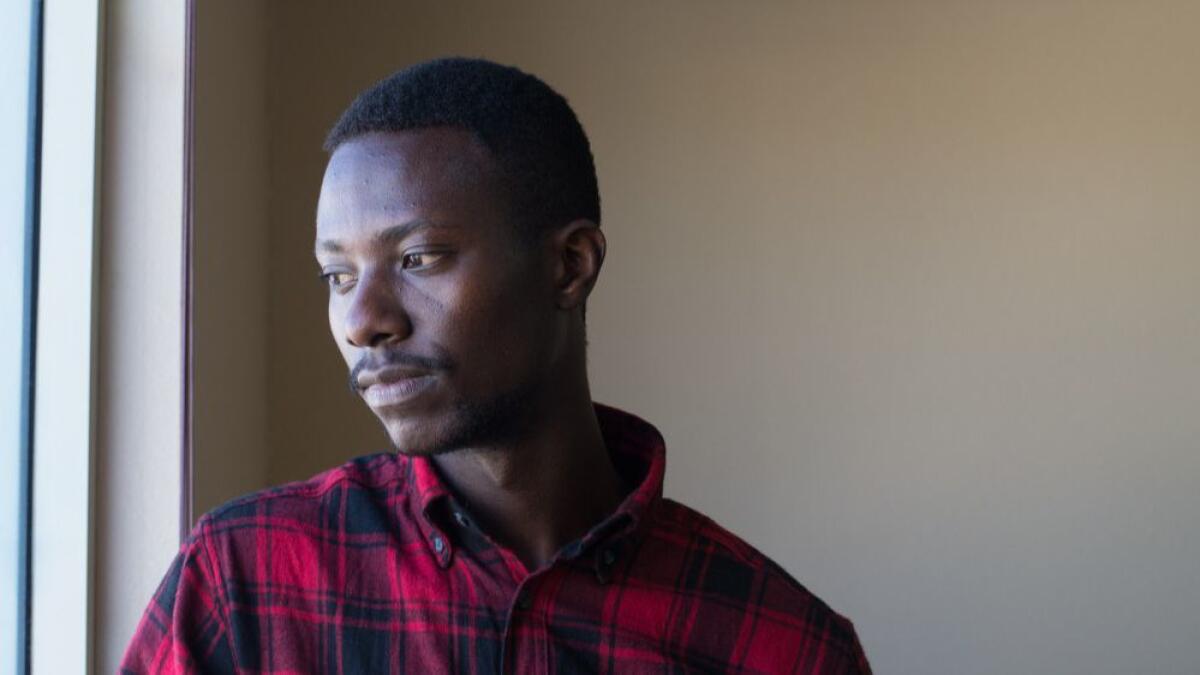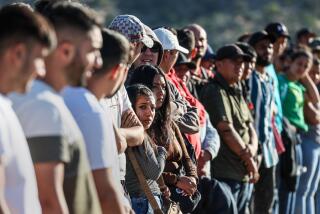With fewer refugees coming, resettlement agencies may be forced to close

When Christian Ilaka wakes up, the first thing he sees on his wall in large letters is the word “Focus.”
The 25-year-old uses the reminder to motivate himself to do what he needs to do to succeed in his new life in the U.S.
Ilaka, originally from the Democratic Republic of Congo, came as a refugee in February with eight family members as part of a shrinking number of newcomers to San Diego County.
While new arrivals from the Democratic Republic of Congo, at 115, made up the largest group of refugees who came to the county in fiscal 2018, the overall number of Congolese resettled in San Diego decreased to the lowest number since 2014, when 53 came.
Iraqis used to be the largest group of newcomers to the county, and so many came that they made San Diego the California county that resettled the most refugees for about a decade. That changed in fiscal 2018, with new policies in place from the Trump administration drastically lowering the overall number of arrivals as well as changing who was able to come.
Though President Trump took office during fiscal 2017, this past fiscal year, which ended in September, was the first full year with his changes and the first time those changes knocked San Diego County from the top of the list.
The county resettled 264 refugees in fiscal 2018, an 82% drop from the 1,503 who came in fiscal 2017, and a 91% drop from the 3,075 who came in fiscal 2016. More refugees came to San Diego in one month during previous fiscal years than did for all of fiscal 2018.
Trump set the annual cap last year at 45,000 refugees. The U.S. resettled just under half of that at 22,491. That’s also lower than the planned cap for fiscal 2019, proposed at 30,000.
Secretary of State Michael R. Pompeo said in announcing the new cap that the reduction was to account for an increase in asylum requests at the U.S.-Mexico border.
“The refugee ceiling number should not be viewed in isolation from other expansive humanitarian programs,” Pompeo said. “Some will characterize the refugee ceiling as the sole barometer of America’s commitment to vulnerable people around the world. This would be wrong.”
Pompeo also defended the longer processing times that have come with Trump administration changes to the resettlement program.
“The American people must have complete confidence that everyone granted resettlement in our country is thoroughly vetted,” Pompeo said. “The security checks take time, but they’re critical.”
Resettlement agencies fear that the new cap of 30,000 could mean the number of actual arrivals shrinks even more.
“Our intent is to really hold the government accountable for reaching that target knowing we have many people in harm’s way and in desperate situations,” said Donna Duvin, executive director of the International Rescue Committee in San Diego.
For Etleva Bejko, director of refugee and immigration services at Jewish Family Service, watching the number of arrivals shrink has been especially difficult knowing that conflicts around the world have created more refugees registered with the United Nations than ever before.
“When you do this work day-to-day, and you work with the clients, you’re not even thinking about the numbers as much,” Bejko said. “Each one is a family that is trying to do their best, focusing on their children. All they want is to be safe and have a future.”
Her agency helped a family of seven refugees from Myanmar, also known as Burma, get settled this year. They had been waiting since 1999.
“This is the day I have been living for,” the mother told Bejko after the family arrived.
For other families, arriving in the U.S. doesn’t mean that the wait is over. Many have family members still waiting overseas for their processing to finish.
“It’s just heartbreaking to see somebody worrying about family constantly and not be able to have a final answer,” Bejko said. “People are still in process, but it’s taking longer to get information.”
The International Rescue Committee was able to reunite at least one person — a Rohingya refugee fleeing Myanmar — with family here, according to Duvin.
The agency also began receiving refugees being held by Australia on Nauru Island. The process, based on an agreement the U.S. made with Australia before Trump took office, has been slow, Duvin said, but she was happy that some were making it through.
Resettlement agencies such as Jewish Family Service and International Rescue Committee have had to restructure their programs because of the lower numbers of arrivals. When staff positions fell vacant, they often went unfilled. Those who remained shifted to providing longer-term services to refugees who had already arrived, and agencies became increasingly reliant on private donations to fund their work.
With the shifting focus from resettling refugees from the Middle East to resettling those from African countries, the International Rescue Committee has also been recruiting Swahili speakers.
While resettlement agencies prepare for the possibility of even fewer arrivals in fiscal 2019, they still don’t know how much money they will receive to do their work or whether they will be allowed to stay open. Since the Trump administration is still working out details about the 2019 resettlement efforts, it has not yet released its budget for the program for this year.
Local resettlement agencies are operating through December with leftover money from the fiscal 2018 budget because the number of resettled refugees didn’t reach the 45,000 cap. They have been told that some of the nine agencies nationwide may be asked to close their doors once the 2019 budget is finalized.
A State Department official confirmed that the administration is expecting to fund a smaller number of resettlement agencies.
“We expect to have a resettlement network that is smaller but still national in scope,” the official said. “Decisions regarding the location of resettlement affiliates will be based, as they have always been, on prioritizing family reunification and consideration of the local resettlement environment and economy.”
For Ilaka, the shrinking numbers of arrivals have personal impact because he has friends back in the refugee camp in Uganda where he lived for eight years who are still waiting to come. He celebrates what he has here, but he faces constant inner conflict about how much he can help the people left behind while he works to better his own future.
He compared the feeling of waiting in the refugee camps to that of waiting for a bus that is supposed to come in 10 minutes but doesn’t arrive for 10 hours. He waited for so long that it felt like he had no choice but to wait more. He could’ve started walking, he said, but then if the bus came, he would’ve had to run back to catch it.
“You have to be there to know what it’s like to be a refugee, to be waiting for something you have no control over,” Ilaka said. “You go to bed, wake up the next morning and hope. That’s the only thing you have when you’re a refugee — hope.”
He recalled the pain of telling the intimate details of the worst moments of his life to officials who were deciding whether he counted as a refugee. The longer a refugee waits to be resettled, the more they have to tell those stories, he said.
He keeps the trauma buried in the back of his mind and tries not to think about memories like the Six-Day War that rained hundreds of bombs and thousands of bullets on the town he lived in when he was about 6 years old.
He was at school when the war broke out, a hailstorm of bullets echoing in his classroom. He took shelter under his desk for hours until a stranger arrived that afternoon to help him get home.
He remembers running past the bodies of older students who had tried to go home earlier in the day and having to jump over some of the dead as he made his way across town.
Exhausted from running, he and the man helping him stopped for a moment to rest under a tree. Right after they started moving again, a bomb exploded at the spot where they had been standing. Once they reached home, Ilaka hid in his basement until the end of the war. He couldn’t eat meat for a long time because it reminded him of what he had seen.
“This nightmare you can’t explain,” Ilaka said. “The images you can’t make sense of. There are a million ways to die. Some you can’t explain. It just sticks in the head.”
In addition to working a job at a factory assembling car parts and going to school for software engineering, Ilaka is interning with the International Rescue Committee’s youth program to mentor high school boys. He hopes to inspire them to go after their dreams early in life.
“The American dream, it’s what you make of it,” Ilaka said. “That’s what I like about this place — you have the power to decide what you will make for your future.”
Morrissey writes for the San Diego Union-Tribune.
kate.morrissey@sduniontribune.com, @bgirledukate on Twitter
More to Read
Sign up for Essential California
The most important California stories and recommendations in your inbox every morning.
You may occasionally receive promotional content from the Los Angeles Times.











